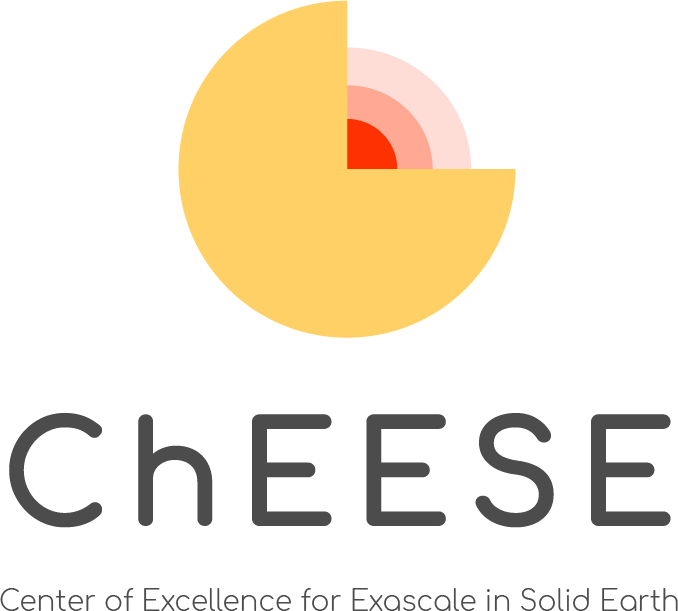ChEESE is a center of excellence in solid earth. Its primary objective is to develop 11 flagship codes to address 12 specific computational challenges related to computational seismology, magnetohydrodynamics, and physical volcanology. The codes will be optimized to ensure high performance across various types of accelerators and will be scalable, deployable, portable, and containerized. These codes and workflows will combine to create a new generation of 9 pilot demonstrators that will incorporate concepts such as multi-scale, multi-source, and multi-physics. These demonstrators will be used to simulate 15 scenarios representing capability and capacity use cases that are of particular importance in terms of science, social relevance, or urgency.
Codes
- ExaHyPE supports the simulation of systems of hyperbolic partial differential equations, as stemming from conservation laws. ChEESE has developed a concrete model for seismic wave propagation and dynamic rupture problems. The model utilizes high-order Discontinuous Galerkin discretization and operates on octree-structured Cartesian meshes. As part of ChEESE, ExaHyPE has also been extended to work in uncertainty quantification workflows. The code is available on the GitLab hosted by the Leibniz Supercomputing Center.
- Salvus is a high-performance package for waveform modeling and inversion with applications ranging from laboratory ultrasound studies to planetary-scale seismology. It Solves dynamic (visco-)acoustic and elastic wave propagation problems on fully unstructured hypercubic and simplicial meshes in 2 and 3 dimensions using a spectral-element approach.
- SeisSol solves seismic wave propagation and dynamic rupture problems on heterogeneous 3D models with various material models (e.g., elastic, elastic-acoustic, viscoelastic, poroelastic). It uses high-order discontinuous Galerkin discretization and local time-stepping on unstructured adaptive tetrahedral meshes. Scalable performance at petascale has been demonstrated up to several thousand nodes on several supercompers (e.g., Cori, SuperMUC-NG, Shaheen-II, etc.). The code is regularly updated in the GitHub repository.
- SPECFEM3D solves linear seismic wave propagation (elastic, viscoelastic, poroelastic, fluid-solid) and dynamic rupture problems in heterogeneous 3D models. SPECFEM3D also implements imaging and full waveform inversion for such complex models based on an L-BFGS (Broyden-Fletcher-Goldfarb-Shanno) algorithm. Based on the high-order spectral-element discretization for unstructured hexahedral meshes. The code shows scalable performance at petascale level. It runs on the largest machines worldwide: Titan and Summit at Oak Ridge, Piz Daint, CURIE, K computer, etc.
- XSHELLS simulates incompressible fluids in a spherical cavity. In addition to the Navier-Stokes equation with an optional Coriolis force, it can also time-step the coupled induction equation for magnetohydrodynamics (with imposed magnetic field or in a dynamo regime), as well as the temperature (and concentration) equation in the Boussinesq framework. Based also on a semi-spectral approach combining finite differences in radius and spherical harmonics, semi-implicit second-order time scheme. The code is hosted at the Bitbucket repository.
- ASHEE is a multiphase fluid dynamic model conceived for compressible mixtures composed of gaseous components and solid particle phases. All phases are treated using the Eulerian approach, identifying a solid phase as a class of particles with similar dynamical properties. The physical model is based on the equilibrium-Eulerian approach while the gas-particle momentum non-equilibrium is approximated by a prognostic equation accurate to the first order. As a result, the model reduces to a single (vector) momentum equation and one energy equation for the mixture (corrected to account for non-equilibrium terms and mixture density fluctuations) and one continuity equation for each gaseous or solid component. In addition, Lagrangian particles are injected in the domain and two/four-way coupled with the Eulerian field. Discretization is based on the finite-volume method on an unstructured grid. The numerical solution adopts a segregated semi-implicit approach.
- FALL3D is an Eulerian model for the atmospheric transport and ground deposition of volcanic tephra (ash). It solves a set of advection-diffusion-sedimentation equations on a structured terrain-following grid using a second-order finite differences explicit scheme.
- Tsunami-HySEA solves the 2D shallow water equations on hydrostatic and dispersive versions. T-HySEA is based on a high-order finite volume discretization (hydrostatic) with finite differences for the dispersive version on two-way structured nested meshes in spherical coordinates. Initial conditions from the Okada model or initial deformation, synchronous and asynchronous multi-Okada, rectangular and triangular faults.
- Landslide-HySEA solves the 2D shallow water/Savage-Hutter coupled equations, hydrostatic fully coupled, and dispersive weakly coupled versions. L-HySEA is based on high-order finite volume discretization (hydrostatic) with finite differences for the dispersive model, structured meshes in Cartesian coordinates.

